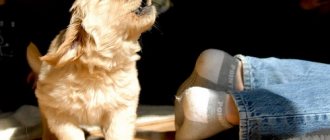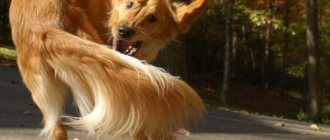Experienced dog breeders know that dogs sometimes suffer from a variety of ailments of viral and infectious origin that can affect many organs of the animal. Sometimes the pet’s behavior changes, which becomes visually noticeable: the dog drifts to the left when walking. Often, such a movement disorder in a dog is caused by vestibular vertigo, when for no external reason the dog loses its balance. Sometimes this condition, when a dog falls on its side when walking, activates profuse drooling, nausea, rapid breathing and increased heart rate. In such situations, experts recommend urgently contacting a veterinary clinic to conduct a full examination of the animal.
Why does a dog drift to the side when walking?
When dizzy, a dog may stagger from side to side and often falls.
Contrary to existing belief, a dog staggers to the right not due to a specific illness, but to a fairly large list of diseases, many of which are considered serious illnesses of the animal.
Common reasons why a dog staggers when walking and falls are:
- the occurrence of severe trembling in the limbs, preventing the dog from standing on its paws; in this case, the animal sits down or lies down;
- the dog has poor coordination of movement, and while running or walking the animal abruptly throws it to the side;
- a dog falling under no possible circumstances;
- inability to perform certain actions, for example, after an illness, a weakened dog falls because it cannot sit or stand.
Additional signs of vestibular disorder, when the dog staggers when walking and faints, is uncoordinated movement of the eyes with a stable feeling of drowsiness, the pet's eyes dart and loss of orientation is observed, and from time to time the animal falls into a feeling of stupor.
Such actions may be caused by damage to the Gaulle and Burdach bundles, or another area of the spinal cord. Attention! The main distinguishing sign of this type of disease is sudden damage to the course: for some time the dog walks in a circle in one direction.
In particularly difficult cases, the dog staggers and falls; an unhealthy animal may not recognize its owners or its own place of residence.
Causes of poor coordination in dogs
If you do not delve into certain types of ataxia, but evaluate the issue of loss of coordination as a whole, among its main causes it is possible to focus on vestibular syndrome, the acquisition of injuries, the occurrence of tumors, the growth of viral processes, poisoning with chemically intense substances (in particular, certain drugs) drugs), inflammatory moments in the hearing organs. In each of these situations, the pet may skid, loosen, or even throw from side to side when moving, but in order to provide assistance, the owner needs to find out the clear cause of the unstable gait, carefully examining the symptoms of all its probable causes.
Rehabilitation
If your dog suffers from narcolepsy or cataplexy and may be in a vulnerable position, you will need to keep an eye on him . Mating, sexual activity, excitement, hunting, swimming, walking without a leash, playing in the park, meeting new people and animals can all trigger an attack. In these situations, you will need to monitor your pet. It is recommended that you keep your dog indoors or in a safe, fenced-in area so that it cannot be attacked by other animals or in any other dangerous situation.
- Like
- COMMENTS
- |
- leave a comment
- |
- Add to favorites 0
Symptoms of disorders
Below are common causes of wobbly behavior in dogs.
Injuries
Sometimes a dog falls on its side and cannot get up as a result of a blow to the temporal bone or an automatic defect in the brain or spinal cord. Based on the specific area of the impact (specifically, they often lead to a similar anomaly), partial paralysis of the limbs, trembling of the hind legs, or an unnatural distortion of the pet’s head are likely. In addition to physical disorders, serious injuries also lead to psychological problems or memory loss, as in the case with an effect on the cerebellum.
Injuries affect animal coordination
Tumors
Growths in the animal's brain or inner ear can also cause an animal to walk unsteadily. Malignant brain tumors are deservedly considered very dangerous (often leading to the rapid death of the animal), but cysts and polyps can also cause trouble for the owner, especially if they occur in places with important nerve connections. Often, any neoplasms in the brain are more common in older animals, although young pets can also suffer from them.
For this reason, in case of the slightest signs of a violation: when a dog’s leg begins to shake, it sways when moving, falls over or falls, it is worth conducting a comprehensive diagnosis of its body using an otoscope, performing a cytological analysis or even an MRI examination.
Infections
If the root cause of a dog's unsteady gait and lack of body control is infection, then most likely its source is concentrated in the brain. Very common ailments in this regard are carnivore plague, meningoencephalitis, myelitis, encephalitis, toxoplasmosis and cryptococcosis, although fungal or viral lesions of the organ are not uncommon. Infections of the brain can serve as the basis for the progression of epileptic seizures, during which the animal jerks its limbs chaotically, bends its body like a drunk, writhes from convulsions and faints.
After a certain period of time, the attack passes and the dog behaves naturally until the next time.
Attention! The treatment of epilepsy is not particularly effective, so the owner can only take care of the pet during seizures, preventing it from being injured.
With epilepsy, a dog's eyes wander, there is loss of orientation and seizures
Poisoning
Poisoning, as the initiator of deformation of coordination in a dog, can be caused by toxins both as a result of chemical poisoning and by products that enter the body during the life of helminths. A significant number of parasites in a dog’s body leads to encephalopathy, which is also characterized by disruptions in movement coordination.
Inflammation of the ears, or otitis media in the area of the animal's middle and inner ear, is often the first cause of vestibular syndrome, since the organ of balance, defined as the “labyrinth of the cochlea,” is connected to hearing. An increase in the area of inflammation also leads to disruptions in the dog’s coordination when walking, and in some cases even to partial paralysis of the animal’s limbs. In this regard, the sooner the dog’s owner begins anti-inflammatory and antibacterial therapy, the sooner he will be able to return the dog to normal life.
Stages of epileptic seizures
Epileptic seizures can last from several minutes to several hours. Epilepsy is characterized by three main stages:
Aura . The initial stage, occurring immediately before the onset of an attack. At such moments, the animal begins to show the first signs of anxiety; trembling throughout the body and drooling may be observed, in some cases - complete immobility. The dog is clearly nervous, whines, tries to hide from prying eyes, and has disorientation in space.
Ictal is actually the beginning of an attack. The animal may lose consciousness, lose control over its own body, limbs involuntarily bend and unbend, muscles become stiff, the dog falls on its side, eyeballs roll back, breathing becomes frequent and heavy. During a seizure, the dog may make squealing sounds, increased salivation occurs, in some cases mixed with blood, and sometimes involuntary urination and bowel movements are observed. The duration of this phase is from several seconds to 5 minutes.
Postictal . The final stage is characterized by disorientation in space, an apathetic state, or vice versa - overly excited. The pet may suffer from confusion, blurred vision, not recognize its owner, and be scared and anxious. Typically, symptoms last from a couple of hours to 2-3 days.
The duration of each stage is individual, it is important to take precautions and help your pet survive this difficult moment.
Diagnostic measures
The owner is unlikely to be able to personally determine the reason why the dog is moving backwards. Therefore, as soon as you notice the dog’s uncertain movements or trembling of its paws, you need to take the dog to the veterinarian. Of course, doctors do not have any single prescription.
Attention! Only after a comprehensive examination and history collection will an experienced veterinarian be able to determine the root cause of coordination failure.
Among laboratory tests, a general analysis of blood and urine will be in demand, and additional methods of data collection may include X-ray examination, which can make it possible to exclude head injuries and internal secretory otitis media, and MRI, which provides more complete information regarding the presence of tumors in the brain and inflammatory diseases. processes.
Having excluded the main ailments with coinciding symptoms (metabolic disorders, parasitic diseases or diseases of internal organs), the specialist is able to narrow the selection circle, and at the end he can only examine the condition of the external ear canal and eardrum. If, as a result of the examination, a rupture of the eardrum was found, then it is possible to suspect otitis of the middle and inner ear as a factor in the failure of movement coordination.
Diagnostics
The dog's medical history is comprehensively studied. A complete physical and neurological examination is performed. The animal is sent for computed tomography, skull radiography and electroencephalogram. Hematological, biochemical and helminthological tests are carried out, namely:
- general urine analysis;
- general blood analysis;
- residual nitrogen in urea;
- blood glucose;
- lead and calcium;
- coprogram.
If the veterinarian, after a full examination, does not find an identifiable cause of the attacks, then the true form is diagnosed.
What to expect when visiting the veterinarian
If the owner, faced with similar symptoms in the pet’s behavior, does not understand why the dog walks poorly and falls, then it is necessary to go to the veterinarian for a full examination. Timely detection of the causes of the disease is considered a very important condition for the complete recovery of the animal; sometimes this may require a number of studies: ultrasound, x-ray, and in some situations CT or MRI of the brain.
The upcoming treatment should be based only on the diagnosis made by the veterinarian
Therefore, the sooner the owner contacts a specialized institution, the more effective the pet’s treatment will be.
A treatment plan with the choice of specific medications to restore the dog's normal coordination is developed based on research. So, if the root cause of the disorder is an inflammatory process, then it will be necessary to use potent medications, and if the pet is severely disoriented or even angry, sedative medications can help.
Tumors and other dangerous neoplasms are removed surgically, with subsequent treatment with chemotherapy for malignant tumors, or a maintenance course of vitamin medications, if a benign tumor is detected. When a hereditary factor is considered the first cause of the progression of the disease, it will not be possible to completely cure the animal, and all that the owner can do is relieve painful seizures from time to time.
In such techniques, as a rule, drugs are used that activate blood circulation in the brain and normalize metabolism in nerve tissues. Non-steroidal anti-inflammatory, antispasmodic and diuretic medications are prescribed by a veterinarian if the dog has fluid retention in the tissues.
Attention! A certain dosage is selected individually by the veterinarian, based on the dog’s age and the consequences of the disease.
Which breeds are more susceptible to muscle spasms?
As noted above, in this article, small breeds are at risk : dwarf Spitz, Yorkshire terriers, Chihuahuas. The reasons are different. Premature birth and poor feeding guarantee an imbalance of glucose and calcium. Stressful situations and changes in the usual environment also affect the metabolism of these children. Miniature individuals have a weaker nervous system.
Of the large breeds, labradors, huskies, and collies are most often affected. From medium poodles and dachshunds. Here, more often than not, heredity plays a significant role.
Experienced breeders know that epilepsy can manifest itself in the early stages of development of babies, so it is possible to select puppies with manifestations of the disease. The first sign of which is convulsions.
How to help your pet
A dog’s swaying while walking is a very dangerous and difficult phenomenon for the animal; for this reason, the owner is obliged to do everything possible to prevent the development of the disease and, with the help of a veterinarian’s testimony, to prevent the development of an irreversible pathology when the dog constantly drags its feet.
The list of main preventive measures in the above version includes:
- Purchasing puppies only from responsible breeders who do not use individuals with hereditary problems for breeding.
- Appropriate treatment of non-contagious and infectious diseases of your pet.
- Use for feeding only the most balanced feed mixtures containing the required amount of B vitamins.
- Compliance with the vaccination schedule.
- Ensuring the animal's constant access to purified drinking water.
- Regularly check your dog's health.
- Contact your veterinarian immediately if there is such a change in your pet’s behavior.
Timely vaccination is an important preventive measure.
In addition, in order to protect your beloved dog from infections, you need to promptly take the animal for a hygienic haircut and perform other mandatory hygiene procedures: cleaning the dogs’ ears and trimming their nails.
There are actually many reasons for an unsteady gait and they are not always safe. Only a visit to a veterinarian will guarantee the diagnosis of the disease in which the dog is moving backwards, and will protect your beloved pet from dire consequences.
First aid
It is difficult for an ignorant person to expect an attack or predict its approach, but it is possible to be prepared for such a situation. The duration of the seizure or its course cannot be influenced. The goal is to prevent more severe consequences.
- Record how long the spasms and other noticeable manifestations last. Observe which muscles cramp the most: the front legs, the hind legs or the whole body.
- Try to prevent the dog from hitting objects, a wall, a tree, or falling down the stairs.
- Place your pet on the bedding.
- At the end of the seizure, gently stroke and offer water. You should not feed yet.
- Support your dog emotionally with care. She is confused and does not understand why this is happening.
- If a pain attack does not end for more than 10 minutes or after completion the pet does not come to its senses for more than thirty minutes, you need to call an ambulance or go to the doctor yourself.
Life-threatening convulsive syndrome - epistatus. The attack lasts 5-7 minutes and is repeated at intervals of less than 30 minutes. Requires immediate assistance.
It is forbidden:
- stick out your tongue, try to open or close your mouth;
- leaving your pet alone;
- It is advisable that during and after a seizure the animal is not frightened by loud sounds or irritated by strong and pungent odors.
Animal breed
Some dog breeds are prone to seizures. For example, Scottish and German shepherds, as well as beagles, are susceptible to epilepsy. Lhasa Apsos often experience seizures due to congenital flattening of the brain convolutions (lissencephaly). In decorative breeds, such symptoms may be associated with hypoglycemia or hydrocephalus.
Scottish Terriers often have a hereditary neuromuscular disease called “Scotty Crump.” When nervous or during training, the animal’s facial muscles begin to contract and its back arches, making breathing difficult. This phenomenon is observed only in dogs of this breed. The exact cause of this syndrome is unknown, but veterinarians speculate that it is due to excess serotonin secretion.
Symptoms
In each specific case, the disease manifests itself completely differently, but certain signs characteristic of such diseases can be identified.
- Defecation and urination are impaired. At the same time, the forms of deviations from the norm can be different - incontinence, constipation, on the contrary, diarrhea, pain when urinating, and so on.
- In the initial stages, gait is disturbed, a certain uncertainty and unsteadiness appears. At first, the owners do not attach much importance to this, saying that the dog is tired or is just fooling around. In fact, a wobbly gait is a sure sign of serious problems, including a precursor to hind limb paralysis in dogs.
- Motor capabilities are lost, the paw (one or more) seems to “get stiff” and stops bending normally.
- The dog tries to move in such a way that the main load falls on the front part of the body and, accordingly, the paws. Often in this situation she simply drags her hind legs.
- In some cases, the paws themselves “swim” and become completely soft, even to the touch. Most importantly, bones become brittle, leading to an increased risk of injury.
- The animal often tries to retire somewhere and lie quietly so that no one bothers it.
- In some cases, very aggressive behavior of pets is noted. But this is understandable. When there is constant, aching pain, there is no need to talk about an agreeable character.
Unsystematic sudden dizziness
About 30% of complaints about dizziness and loss of balance are called false, that is, non-systemic. The sensations are not associated with the development of the disease and can occur in the following situations:
- a sharp change in body position when standing up after prolonged sitting or lying, a sharp turn of the head. The feeling of loss of balance lasts seconds and is associated with the redistribution of blood in the vessels;
- the appearance of feelings of fear or anxiety. Dizziness is caused by a psychological factor;
- overwork, lack of sleep;
- lack of nutrients during an irrational diet;
- dizziness during pregnancy may be associated with the development of anemia, fatigue, changes in the body during pregnancy;
- intoxication with medicinal, alcoholic and narcotic substances causes a feeling of loss of balance and dizziness due to the toxic effect on the vestibular apparatus.
Drug therapy
In cases where obsessive-compulsive disorder has developed over a long period of time, drug therapy is used. Drugs designed to treat obsessive-compulsive disorder in people have a certain effect. These are medicines containing clomipramine or fluoxetine. Typically, the effect of taking medications begins to appear only after a few weeks.
Isolated, drug treatment is ineffective; to achieve the desired result, it must be combined with elements of behavioral therapy.
Under no circumstances should you treat your dog on your own! Drug treatment should only be carried out under the supervision of a veterinarian!
Causes
As already noted, many negative factors can cause such serious physiological consequences. Among them, it is worth highlighting the following most common:
| Infectious diseases | If they occur in a severe form, alternatively, it could be canine distemper, which occurs quite often in unvaccinated dogs. |
| Mechanical damage | Or rupture of nerve fibers as a result of accidents or intentional beatings. There are frequent cases of animals getting hit by cars. |
| Inflammatory processes | Although infrequent, they can still cause paralysis of the hind limbs in dogs. |
| Strokes and heart attacks | A very likely factor is loss of sensitivity, at least partially in the paws. |
| Oncology | In all forms of its manifestation. Such a diagnosis is not something to joke about. And here it is important to take the most serious measures. |
| Ticks | Carriers of serious infections have recently posed a threat not only to domestic animals, but also to humans. |
But there is another aggressive and inevitable factor that can lead to paralysis. And there seems to be no way to fight it at all. We are, of course, talking about old age and physical and physiological, and natural, wear and tear of the body.











